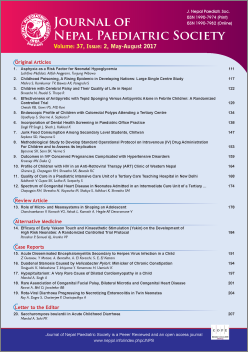Effectiveness of Antipyretic with Tepid Sponging Versus Antipyretic Alone in Febrile Children: A Randomized Controlled Trial
DOI:
https://doi.org/10.3126/jnps.v37i2.16879Keywords:
Antipyretic drug, Fever, Tepid spongingAbstract
Introduction: Fever is the most common presenting complain for which children are brought to the paediatrician.Physical methods are widely used in treating febrile children, tepid sponging being commonly practiced in hospitals along with antipyretics. The objectives of this study were to compare the effectiveness of tepid sponging and antipyretic drug versus antipyretic drug alone in febrile children.
Material and Methods: This was a Randomized controlled trial done in JSS Medical College and Hospital. All children under the age of 6 months to 12 years, admitted with axillary temperature of >99oF were included in the study. A total of 500 children were included over two years study period. Children with recorded axillary temperature of >990F were randomized into control and study group by computer generated randomisation. Children in the control group received only paracetamol (15mg/kg) at 5 minutes and combined group received paracetamol and tepid sponging at five minutes. Axillary temperature was monitored every 15 minutes for a period of 2 hours in both the groups.
Results: There is no significant difference in reduction of temperature between the two groups by the end of two hours. Children in combined group had a higher level of discomfort than those in only antipyretic group.
Conclusion: Tepid sponging does not add to the efficacy of paracetamol in antipyresis and that addition of tepid sponging to antipyretic, results in additional discomfort for the child. This study, therefore, endorses the view that antipyretic alone without tepid sponging should be the modality of therapy in children with fever.
Downloads
Downloads
Published
How to Cite
Issue
Section
License
Authors who publish with this journal agree to the following terms:
Authors retain copyright and grant the journal right of first publication with the work simultaneously licensed under a Creative Commons Attribution License that allows others to share the work with an acknowledgement of the work's authorship and initial publication in this journal.
Authors are able to enter into separate, additional contractual arrangements for the non-exclusive distribution of the journal's published version of the work (e.g., post it to an institutional repository or publish it in a book), with an acknowledgement of its initial publication in this journal.
Authors are permitted and encouraged to post their work online (e.g., in institutional repositories or on their website) prior to and during the submission process, as it can lead to productive exchanges, as well as earlier and greater citation of published work (See The Effect of Open Access).



